Book contents
- Frontmatter
- Contents
- List of figures
- List of maps
- List of tables
- Series editor's foreword
- Acknowledgements
- List of abbreviations and acronyms
- 1 Language contact, language learning, and language change
- 2 The general socio-historical context of Portuguese and Castilian
- 3 Portuguese- and Spanish-lexified creole languages
- 4 Bozal Spanish of Cuba
- 5 Chinese Coolie Spanish in nineteenth-century Cuba
- 6 Chinese Immigrant Spanish
- 7 Andean Spanish
- 8 Barranquenho
- 9 Contact, cognition, and speech community
- Appendix A
- Appendix B
- Bibliography
- Author index
- General index
2 - The general socio-historical context of Portuguese and Castilian
Published online by Cambridge University Press: 30 September 2009
- Frontmatter
- Contents
- List of figures
- List of maps
- List of tables
- Series editor's foreword
- Acknowledgements
- List of abbreviations and acronyms
- 1 Language contact, language learning, and language change
- 2 The general socio-historical context of Portuguese and Castilian
- 3 Portuguese- and Spanish-lexified creole languages
- 4 Bozal Spanish of Cuba
- 5 Chinese Coolie Spanish in nineteenth-century Cuba
- 6 Chinese Immigrant Spanish
- 7 Andean Spanish
- 8 Barranquenho
- 9 Contact, cognition, and speech community
- Appendix A
- Appendix B
- Bibliography
- Author index
- General index
Summary
The Romanization of the Iberian peninsula
In contrast to Gaul, which Caesar conquered in just ten years, Iberia, defying the best Roman generals, succumbed to Rome only after a bitter struggle spanning more than two centuries. In fact, during most of the 202 years between 218 BCE and 16 BCE, it is not an overstatement to say that Iberia was a war zone (Curchin 1991:7).
Before the soldiers of Rome reached Iberia in 218 BCE, speaking colloquial varieties of Oscan, Umbrian, and Latin, the Iberian peninsula was inhabited by numerous tribes. In the west and north of the peninsula were the people the classical writers describe as Celtic, who had been in the region as early as the ninth century BCE, though they may have arrived in various waves (Tovar 1977:121–122). In the south-west lived the Lusitanians, and the Galicians inhabited the north-western corner of the peninsula. Whereas the language of the Lusitanians may have been pre-Celtic, or an early Celtic language, that of the Galicians (Callaeci) was definitely Celtic, possibly a more recent variety than that of the Lusitanians (ibid.:109–110). The differences between their languages notwithstanding, the Lusitanians and Galicians were quite similar to one another in the degree and form of their civilization (de Oliveira Marques 1972:17).
In the north-central part of the peninsula lived the Basques, who spoke a non-Indo-European language. The central region of Iberia was inhabited by various tribes collectively known as the Celtiberians, who spoke varieties of Celtic (Tovar 1977:105–106), and in the south-central area were the Tartesians. For their part, the Iberians inhabited the eastern coast, up to the current border with France.
- Type
- Chapter
- Information
- The Linguistic Legacy of Spanish and PortugueseColonial Expansion and Language Change, pp. 28 - 41Publisher: Cambridge University PressPrint publication year: 2009

